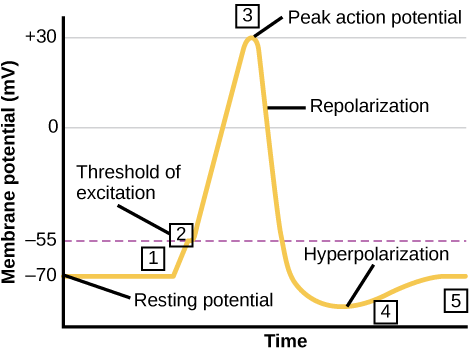Overview of Action Potential
An action potential is a rapid, temporary change in the electrical membrane potential of a cell, primarily neurons and muscle cells. This process allows for the transmission of electrical signals along the cell membrane, facilitating communication between cells in the nervous system and contraction in muscle cells.
Phases of the Action Potential
- Resting Membrane Potential:
- The resting membrane potential is typically around -70 mV in neurons, maintained by the sodium-potassium pump (Na+/K+-ATPase) and leak channels.
- The inside of the cell is negatively charged relative to the outside.
- Depolarization:
- Initiated when a stimulus causes the membrane potential to become less negative (towards zero).
- Voltage-gated sodium channels open, allowing Na+ ions to flow into the cell.
- The membrane potential rapidly rises to around +30 to +40 mV.
- Repolarization:
- Voltage-gated sodium channels close, and voltage-gated potassium channels open.
- K+ ions flow out of the cell, causing the membrane potential to become more negative.
- This phase brings the membrane potential back towards the resting level.
- Hyperpolarization:
- Potassium channels remain open longer than necessary, causing an overshoot where the membrane potential becomes more negative than the resting potential.
- This phase is also known as the afterhyperpolarization.
- Return to Resting Membrane Potential:
- Potassium channels close, and the membrane potential returns to the resting level, maintained by the Na+/K+ pump and leak channels.
Propagation of Action Potential
- Continuous Conduction:
- Occurs in unmyelinated axons.
- The action potential is propagated along the entire length of the axon by sequential opening of voltage-gated sodium channels.
- Saltatory Conduction:
- Occurs in myelinated axons.
- Action potentials jump from one node of Ranvier to the next, significantly increasing the speed of conduction.
- Myelin sheaths insulate the axon, preventing ion leakage and allowing for faster signal transmission.
Refractory Periods
- Absolute Refractory Period:
- Occurs during the depolarization and early repolarization phases.
- Another action potential cannot be initiated, regardless of the strength of the stimulus.
- Relative Refractory Period:
- Occurs during the late repolarization and hyperpolarization phases.
- A stronger-than-normal stimulus is required to initiate another action potential.
Clinical Relevance
- Neurological Disorders:
- Conditions such as multiple sclerosis (MS) involve the degradation of myelin sheaths, impairing saltatory conduction and leading to neurological deficits.
- Cardiac Arrhythmias:
- Abnormal action potential propagation in cardiac muscle cells can lead to arrhythmias, affecting the heart's ability to pump blood effectively.
- Anesthetics and Neurotoxins:
- Local anesthetics (e.g., lidocaine) block voltage-gated sodium channels, preventing action potential propagation and inducing temporary loss of sensation.
- Neurotoxins, such as tetrodotoxin from pufferfish, also block sodium channels, which can be fatal if not managed promptly.
Summary
An action potential is a fundamental physiological process that enables the rapid transmission of electrical signals along neurons and muscle cells. It involves a series of well-defined phases, including depolarization, repolarization, and hyperpolarization, and is critical for various functions such as nerve impulse transmission and muscle contraction. Understanding the mechanisms and clinical relevance of action potentials is essential for comprehending how the nervous and muscular systems function.

